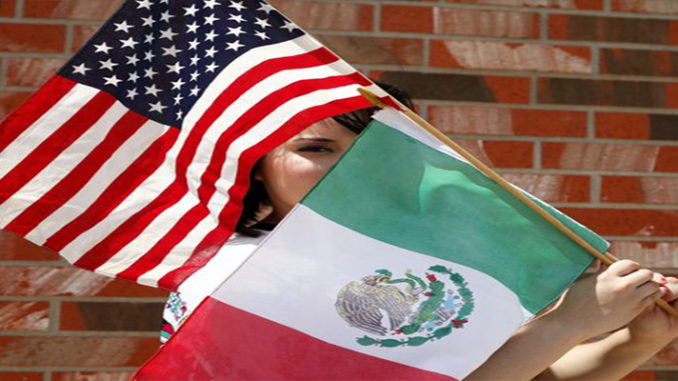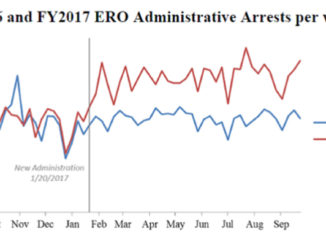
by Alex Gonzalez
Now that Jeb Bush, Rick Perry and Marco Rubio have announced they are running for president, they should avoid the anti-Mexican theme adopted by right-wing culturalists like Ann Coulter and Donald Trump. These three GOP candidates, who have close ties to Mexican-American communities in the southwest, especially Jeb Bush and Rick Perry, need to reiterate to the base that Mexican-Americans – immigrants and those who have been here for generations – are assimilating at the same rate as previous generations.
Opponents of an immigration reform like Scott Walker, Ted Cruz, and Rick Santorum – who are using the issue of Immigration as a populist campaign claiming that immigrants take jobs from low-income white workers – and Donald Trump and like Ann Coulter now leading the anti-Mexican bandwagon, claim that low-skilled Mexicans, who make up the largest subgroup of Latino immigrants, are not fitting into U.S. society — that they don’t want to assimilate and are fated to remain a permanent underclass. However, solid evidence suggests these claims are untrue.
Thiese populist anti-reform views by Walkers, Cruz, and Santorum are easy to debunk with actual data from the work by Diana Furchtgott-Roth from Manhattan Institute. Furchtgott-Roth research shows that:
Immigration spurs economic growth in two ways. First, it expands America’s workforce and encourages more business start-ups. Second, because immigrants’ educational backgrounds typically complement, rather than displace, the skills of the native-born labor market, immigration increases economic efficiency by supplying more labor to low- and high-skill markets.
Thus, this anti-reform populism claiming “low-income white” workers is more about low-income Republican-leaning voters for political purposes in early-primary states. But what about the cultural claims by Ann Coulter that Mexican-Americans do not assimilate, even after many generations?
Many studies in Texas and California clearly shows that Many Mexican immigrants and their children have traveled paths to becoming full Americans that, even if slower, are not unlike the paths followed previously by European immigrants. And when parents have legal status, their children do better in school and become fully productive members of American society more quickly. For example, research by Tomas R. Jimenez from Stanford shows that:
For social scientists, the question of immigrant assimilation is testable. By observing the experiences of Mexican immigrants from first-generation new arrivals through their second-generation children, third-generation grandchildren and so on, the extent to which they become similar to people in the rest of society and integrate into the mainstream becomes apparent.
For Mexicans, who have been immigrating to the United States for a century, the historical moment of arrival and the number of generations removed from the immigrant generation are crucial parts of the story. When accounting for both, the best analyses suggest cautious optimism. Each passing generation of Mexican Americans does better than the one before at making economic gains and progressing toward full integration into U.S. society.
One comprehensive study published in 2008 tracks Mexican Americans’ experiences in the large Mexican centers of Los Angeles and San Antonio, where sociologists Edward Telles and Vilma Ortiz found significant and steady upward educational mobility. On average, first-generation parents completed just 4.1 years school in the 1900s to 1930s. Their second-generation children completed 10 years in the 1930s to 1950s, and their third-generation grandchildren completed 13.1 years of school in the 1950s to 1980s. Later-generation Mexican Americans also narrowed the gaps in educational attainment with non-Latino whites to 1.3 years from 3.4 years.
Those historical findings are echoed in another study by Julie Park, Dowell Myers and Tomás Jiménez that looked at more recent Mexican immigrants. In 1980, just one-fifth of immigrants ages 25 to 44 had completed high school. In 2005, when second-generation children of immigrants reached the same age range, more than four-fifths had graduated. Similar generational improvements also were seen in wages earned, rates of homeownership and percent living above the poverty line. The gaps between Mexican immigrants and non-Latino whites declined from the first to second generation in all areas (except for homeownership, where no gap exists).
Rates of intermarriage reflect declining social barriers between groups perhaps more than any other indicator. Across generations, Mexican Americans increasingly marry partners from other ethnic and racial backgrounds, usually non-Latino whites. Even in Los Angeles and San Antonio — where many people of Mexican heritage live, thereby increasing chances for marriages within the ethnic group — roughly 1 in 3 third- and fourth-generation Mexican Americans are married to someone from another background.
It is important to highlight the progress of many Mexican Americans. Indeed, they have made this uphill climb in spite of greater challenges than those faced by earlier, European immigrants. An extensive historical study published by sociologist Cybelle Fox in 2012 shows that Europeans who came at the turn of the 20th century were far more likely to receive government aid than Mexicans or blacks, regardless of need. Local relief officials also protected European immigrants from federal agents who were investigating public aid recipients during the Depression. In stark contrast, officials repatriated Mexican immigrants and their U.S.-born offspring, who also faced Jim Crow-like racism in many parts of the country.
For contemporary Mexican immigrants and their U.S.-born children, the biggest challenge to assimilation is illegal status. A 2012 study by sociologist Roberto Gonzales shows that illegal status prevents aspiring immigrant youths from attending many U.S. colleges or working in the jobs they have been preparing for. After high school, their fortunes converge with those of less-educated immigrants, and their belief that hard work and good grades will pay off shatters.
So whatever the rhetoric may be espoused to sound “tough on immigration,” which quickly shifts into anti-Mexican and anti-native Latino, when Mexicans have the opportunity to live and work legally in the United States, the new arrivals and their descendants are more likely to overcome disadvantages and, as immigrants have always done, become strong and constructive contributors to our diverse society.
If anything, Rick Perry, Jeb Bush and Marco Rubio can make the economic argument that this young generations of Mexican-Americans – the largest ethnic group in the nation – will be paying for the national debt accrued by payments to Entitlements. Or they can talk about of the benefits of free trade with our southern neighbor that supports almost six million American jobs. That is a conservative Republican message that will appealing to millions of Mexican-Americans voters, and communities, across the southwest.
Alex Gonzalez is a political Analyst and Political Director for Latinos Ready To Vote. Comments to [email protected]



